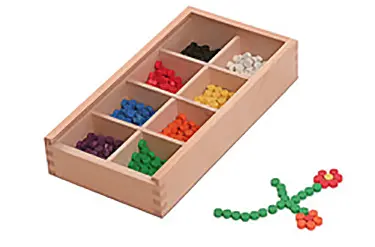Gift Nine: The Point
Ninth in a series of 10 Gifts, Froebel’s Gift 9 features small objects, often in a variety of colors, to represent the point.
Continuing the logical cycle, from the solid forms of Gifts 1-6, the surface of Gift 7, the lines of Gift 8, and now to Gift 9, children are now asked to create using only points. So, the progression of Gifts has reached a higher level of abstraction – a point with no dimension, essentially only “position” is referenced. Froebel understood that children cannot be taught these abstract concepts, but they can discover them through play and internalize these ideas. The impressions formed by doing creates a solid foundation of understanding.

All knowledge is built on previous knowledge, and every activity reinforces this knowledge. The young mind is still organizing its concept of the world and these brightly colored wood pieces invite a child to explore these concepts in a playful way. By playing with the child and asking questions, the child will reveal his/her thoughts about the world.
It is important to note that, although Froebel used these items in his Kindergarten, he did not establish the sequence of the Gifts after Gift 7. This work was done after his death by his followers and several numbering schemes developed over the years. These instructions are intended to serve as a guide and a brief introduction to Froebel’s methodology. Once you understand Froebel’s playful approach, you will see that the possibilities of this Gift are limitless and that using the Gifts is a creative activity, not a meant to be a rigidly followed procedure.
PRESENTATION
Froebel divided Gift play into three categories: Forms of Knowledge (math/science), Forms of Life (relating to objects found in a child’s
life/world) and Forms of Beauty (abstract patterns and designs). Suggestions for these may be used as appropriate for the child. The enclosed
grid can be used when appropriate but it is not always necessary. Design forms and forms of knowledge are only meaningful if a child can
discover them. They should not be taught didactically.
Children explore the world through play. A young child should always begin play with a Gift using Forms of Life. Children always enjoy building things from their own world and representing whatever is familiar is a wonderful experience for young children. The knowledge (one-to-one correspondence, arithmetic, etc.) can be drawn from what the child has made.
As with all the Gifts, it is important to remember not to give the child too many pieces at once, or allow the child to leave them scattered. Froebel believed that nothing in the world is ever destroyed – only modified. To keep with that idea, the child should keep changing a creation rather than starting over. The enclosed grid should be used when appropriate.
You may choose to first introduce the point along with the solid cube from Gift 2. Start with one or two pieces so that the child will focus on its properties. Have the child note the points on the corners of the cube. What are they? They are not shapes or lines.
FORMS OF LIFE
The children represent objects with a series of points. Begin with a reasonably small number (12) of pieces, all one color. Later you
can increase the number of pieces and vary the colors. Examples of these forms are pictured on the back on this instruction card.
Ask questions. Do you see other points in the room? Always raise their eyes to the world around them. Emphasize the connections.
FORMS OF KNOWLEDGE
Sorting and ordering objects is the foundation of basic mathematics. When used with or without the grid, the points are naturally suited
for this activity. Besides arithmetic (adding, subtracting, etc.), basic concepts of geometry can be explored. What is a point? Does it
have a shape or direction? The idea of position and connecting points to form a line can then be reasoned by the child.
A paper grid (or table with inscribed gridlines) is ideal for exploring the geometry of the point. You may perhaps have the child place a handful of points at the intersection of lines on the grid (on either the 1″ side or the ½” side). The points can form lines (vertical, horizontal, diagonal, etc.) or shapes (circle, triangle, square, etc.). Each line or shape can be used to represent something – a person or object – and can be worked into a story or song. You may also repeat the exercise, placing the points in the center of the grid squares.
FORMS OF BEAUTY
The other Gifts naturally form symmetrical, geometric patterns. Using the grid card with the points will again encourage the child to
produce these type of designs. By allowing the child to create freestyle designs, you will also find beauty and structure in his/her
creations.
Gift play with the points is closely related to drawing, one of Froebel’s Occupations. One of the distinctions between an Occupation and a Gift is that a Gift can be returned to its original form (Froebel spoke of a fundamental law of the Universe that nothing is ever destroyed — it only changes form). Drawing is an Occupation since it cannot easily be undone.
It helps to understand Gift 9 in this context. Through Gift play, the child will begin to see the universe in terms of solids, surfaces, lines and points. In drawing, the child may perceive lines as a series of connected points. Points also exist in three dimensions. Gift 10, the final Gift, creates a skeletal structure of a form using both points and lines.
